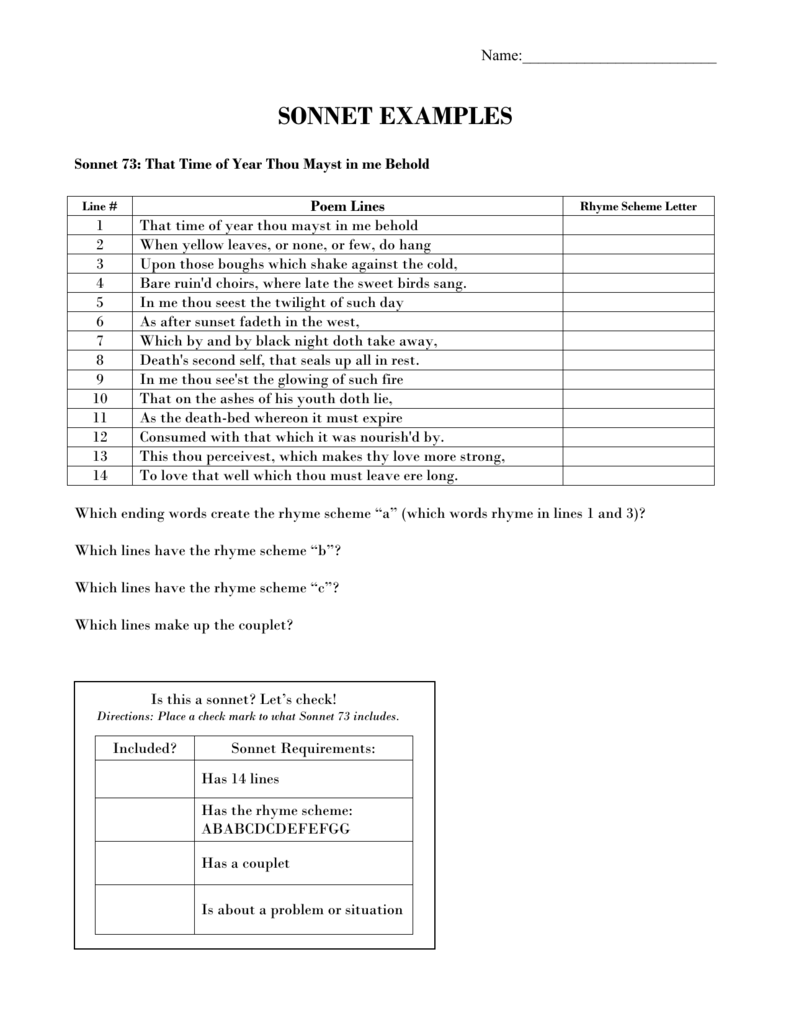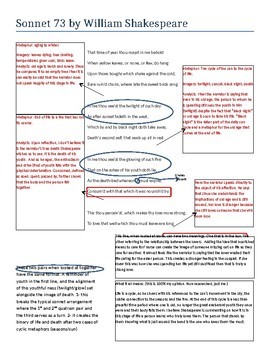

That time / of year / thou mayst / in me / behold "Sonnet 73" will use this particular rhythm and meter through most of the poem. I will use bold to illustrate the stressed syllables. Let us look at the first line of the poem to illustrate this point. That is why it is called iambic pentameter.

Shakespeare will use this rhythmic foot five times per line, and that gives each line 10 total syllables or five iambic feet. An iambic foot is composed of an unstressed syllable followed be a stressed syllable. Being a Shakespearean sonnet, this poem's rhythm and meter is iambic pentameter. I am going to assume that the question is asking about "Sonnet 73" by William Shakespeare. In such a case, we would still describe the poem as being written largely in iambic pentameter. However, sometimes we will find a poem written in iambic pentameter where one or two of the lines doesn't quite fit-maybe it has four iambs, or six. Now, the meter in this poem is perfect-all the lines conform exactly to the iambic pentameter guideline. The capitalized syllables represent the places where we'd give stress to the sentence if we were reading it aloud. Let's look at a line from this poem poem: That TIME of YEAR thou MAYST in ME beHOLD. So, iambic pentameter does not mean that there are only five syllables in a line, but that there are five points of emphasis. An iamb is an unstressed beat followed by a stressed beat (or emphasized syllable). It is iambic pentameter, a meter in which each line contains five iambic feet, or iambs. User: The nymph wants the shepherd to offer her more material possessions.If you have read any of Shakespeare's other sonnets-or indeed, any sonnet in the traditional form-you may recognize this meter. The conditions she places are completely idyllic. She would live with him if youth and joy lasted. Weegy: She points out that winter replaces spring, rivers rage, rocks grow cold, birds stop singing and flowers fade. User: What flaws does the nymph find in the shepherd’s idyllic vision? On what condition would she agree to live with him? Weegy: MORTALITY is the theme of Shakespeare's Sonnet 73. Weegy: In Sonnet 73, how does the speaker s age affect his beloved? The answer is a. User: In Sonnet 73, how does the speaker’s age affect his beloved? Weegy: In Sonnet 73 the speaker uses analogies to describe himself. User: In Sonnet 73 the speaker uses analogies to describe himself. The thematic effect of the couplet (last two lines): This thou perceivest, which makes thy love more strong, [ To love that well which thou must leave ere long means The speaker is proud of his beloved. The speaker is angry that he is no longer young. The speaker understands how the beloved views his age.

The speaker changes his mind about youth. To love that well which thou must leave ere long. This thou perceivest, which makes thy love more strong, User: What is the thematic effect of the couplet (last two lines): Weegy: Best describes the tone used in sonnet 73 is - a. User: Which of the following best describes the tone used in Sonnet 73? Weegy: Shakespeare meant Death's second self as : b. User: Sonnet 73 is writen in iambic pentameter.

Each quatrain in Sonnet 73 contains a new and different metaphor than the one before it. User: Each quatrain in Sonnet 73 contains a new and different metaphor than the one before it. Weegy: The speaker in Sonnet 73 is addressing his imminent death. User: The speaker in Sonnet 73 is addressing his imminent death. A sonnet is a poem of fourteen lines using any of a number of formal rhyme schemes, in English typically having ten syllables per line.


 0 kommentar(er)
0 kommentar(er)
